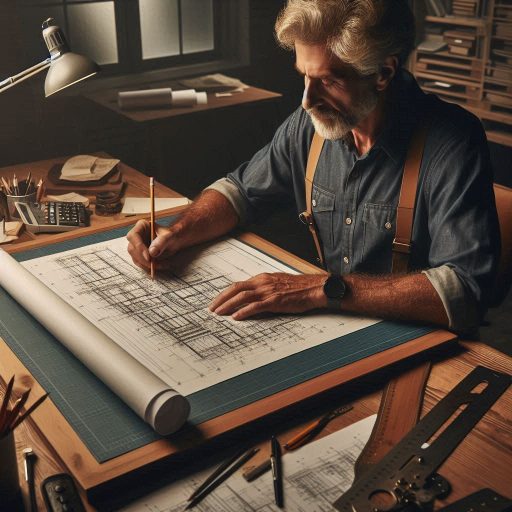Introduction
Define What a Professional Drafter Is
A professional drafter is a skilled technician who creates detailed technical drawings and plans.
These drawings are crucial for turning concepts into precise visual representations.
Drafters use specialized software and tools to produce accurate and comprehensive designs.
They ensure that projects meet specifications and regulatory requirements.
Their work supports various industries by providing essential visual documentation.
The Importance of Drafters in Various Industries
Drafters play a vital role in several industries.
In construction, they create blueprints for buildings and infrastructure, ensuring accurate construction.
Manufacturing, they design detailed schematics for products and machinery, facilitating precise production.
In aerospace and automotive industries, drafters produce intricate designs for advanced technologies.
Their ability to translate complex ideas into clear, detailed drawings supports engineers, architects, and manufacturers, making their contributions indispensable.
The Different Career Paths Available for Drafters
Drafters can pursue various career paths depending on their interests and industry needs.
Common roles include civil drafters, who focus on infrastructure and building projects; mechanical drafters, who design machinery and mechanical systems; and electrical drafters, who create wiring diagrams and electrical systems.
Other specializations include architectural drafters and aerospace drafters.
Each path offers unique challenges and opportunities, catering to different aspects of design and engineering.
Research the Field
Different Types of Drafting Specialties
Start by exploring various drafting specialties.
Each specialty, such as architecture, engineering, or construction, has distinct focuses.
For instance, architectural drafting involves creating detailed plans for buildings, while engineering drafting centers on technical schematics for machinery and infrastructure.
Understanding these differences will help you find a niche that aligns with your interests.
Look into the Education and Training Requirements for Each Specialty
Next, examine the educational and training requirements for each specialty.
Architectural drafters often need a degree in architecture or a related field.
Engineering drafters typically require education in engineering technology or a similar discipline.
Construction drafters might benefit from courses in construction management or specialized training.
Certifications can further enhance your qualifications and open additional career opportunities.
Key Skills Needed to Succeed as a Professional Drafter
Identify the key skills essential for success in drafting.
Attention to detail is critical, as accuracy is crucial in drafting.
Proficiency in drafting software, like AutoCAD, is also important for creating precise and professional drawings.
Good communication skills are necessary for collaborating effectively with architects, engineers, and construction teams.
Keeping up with industry trends and technological advancements will help you stay competitive and proficient in your field.
In summary, researching the field involves exploring different drafting specialties, understanding educational requirements, and identifying crucial skills.
This approach will guide you in selecting the right path and preparing for a successful career as a professional drafter.
Read: How to Stay Updated in Environmental Engineering Field
Choose a Specialization
Consider Your Interests and Strengths When Selecting a Drafting Specialty
Begin by evaluating your personal interests and strengths.
Your choice of drafting specialty should align with what you enjoy and excel at.
For instance, if you are passionate about building design and creativity, architectural drafting may be a good fit.
This field involves creating detailed plans for structures, from residential homes to commercial buildings.
On the other hand, if you have a keen interest in technology and machinery, engineering drafting might suit you better.
This specialty focuses on technical schematics and detailed drawings for various engineering projects.
Reflect on what aspects of drafting you find most engaging.
Consider your skills in technical drawing, spatial awareness, and problem-solving.
By aligning your career choice with your strengths and passions, you are more likely to enjoy your work and achieve success in your chosen field.
Research Job Opportunities and Growth Potential in Different Specialties
Next, research the job market and growth potential for each drafting specialty.
Look into current employment trends and future projections.
For example, architectural drafters may experience fluctuating demand based on the construction industry‘s health and housing market trends.
Conversely, engineering drafters might see steady demand due to advancements in technology and infrastructure development.
Explore industry reports, job postings, and labor market data to understand which specialties are in high demand.
Assess the stability and growth potential of each field to ensure you choose a career path with ample opportunities and a positive outlook.
Seek Advice from Professionals in the Field to Make an Informed Decision
Seek advice from professionals already working in the drafting field.
They can provide valuable insights into the daily responsibilities, challenges, and rewards associated with different specialties.
Consider reaching out to industry experts, joining professional organizations, or finding a mentor who can offer guidance.
Networking with experienced drafters or attending industry events can help you gather practical advice and first-hand experiences.
This information will aid you in making a well-informed decision about which specialization best aligns with your career goals and personal interests.
In summary, choosing a specialization involves evaluating your interests and strengths, researching job opportunities and growth potential, and seeking advice from professionals.
This comprehensive approach ensures that your career choice is well-informed and aligned with your aspirations.
Read: Environmental Engineering and Corporate Social Responsibility
Get the Necessary Education
Enroll in a Drafting Program at a Technical School or Community College
Start by enrolling in a drafting program at a technical school or community college.
These programs offer foundational knowledge and practical skills in drafting.
Look for programs that provide training in the specific drafting specialty you are interested in, such as architectural or engineering drafting.
These programs typically cover essential topics, including technical drawing, computer-aided design (CAD), and industry standards.
Technical schools and community colleges offer a cost-effective way to gain the necessary education and hands-on experience.
Completing such a program will prepare you for entry-level positions and help you build a strong foundation for your drafting career.
Obtain Certifications or Licenses Required for Your Chosen Specialty
Next, obtain any certifications or licenses required for your chosen drafting specialty.
Many fields require specific credentials to validate your skills and knowledge.
For instance, certification from a professional organization, such as the American Design Drafting Association (ADDA), can enhance your qualifications and improve job prospects.
Research the certification requirements for your specialty and ensure you meet them.
Some certifications may require passing an exam or completing additional training.
Securing these credentials demonstrates your expertise and commitment to the field.
Consider Pursuing a Bachelor‘s Degree for More Advanced Positions
For more advanced positions or specialized roles, consider pursuing a bachelor’s degree.
While many entry-level drafting jobs can be obtained with a technical diploma or associate degree, a bachelor‘s degree can open doors to higher-level positions and greater career opportunities.
Degrees in fields such as architecture, engineering technology, or construction management can provide a deeper understanding of complex concepts and prepare you for leadership roles.
A bachelor‘s degree can also be beneficial if you aim to advance to managerial positions or work on larger, more intricate projects.
In summary, obtaining the necessary education involves enrolling in a drafting program at a technical school or community college, acquiring relevant certifications or licenses, and considering a bachelor‘s degree for advanced roles.
This educational pathway will equip you with the skills and qualifications needed to succeed in the drafting profession.
Read: The Future of Environmental Engineering Jobs

Develop Technical Skills
Familiarize Yourself with Drafting Software Such as AutoCAD and Revit
Start by familiarizing yourself with essential drafting software like AutoCAD and Revit.
These programs are widely used in the industry for creating detailed and precise drawings.
AutoCAD is renowned for its versatility and precision in 2D and 3D drafting.
Revit, on the other hand, is specialized for Building Information Modeling (BIM) and is crucial for architectural and construction projects.
Mastering these tools will enhance your technical skills and increase your employability.
Practice Creating Accurate and Detailed Drawings
Next, focus on practicing the creation of accurate and detailed drawings.
Use your software skills to work on various projects and scenarios, mimicking real-world drafting tasks.
Accuracy in drafting is crucial, as small errors can lead to significant issues in the final project.
Regular practice will help you refine your skills, develop a keen eye for detail, and ensure that your drawings meet industry standards.
Stay Updated on Industry Trends and Technological Advancements in Drafting
Finally, stay updated on industry trends and technological advancements in drafting.
The field of drafting is constantly evolving with new technologies and practices.
Follow industry news, participate in professional development opportunities, and attend workshops or conferences.
Keeping abreast of these changes will help you stay competitive and ensure you are using the most current and effective tools and techniques in your work.
In summary, developing technical skills involves familiarizing yourself with key drafting software like AutoCAD and Revit, practicing the creation of accurate and detailed drawings, and staying updated on industry trends and technological advancements.
This approach will enhance your proficiency and keep you at the forefront of the drafting profession.
Read: Tips for Writing Environmental Engineering Reports
See Related Content: Benefits of a Career as an IT Support Specialist
Transform Your Career Today
Unlock a personalized career strategy that drives real results. Get tailored advice and a roadmap designed just for you.
Start NowGain Practical Experience
Look for Internships or Entry-Level Positions in Your Chosen Specialty
Begin by seeking internships or entry-level positions in your chosen drafting specialty.
These opportunities provide hands-on experience and practical knowledge in a real-world setting.
Internships allow you to work alongside experienced professionals, apply your skills, and gain insights into the industry.
Entry-level positions offer a chance to start your career and develop a deeper understanding of daily tasks and responsibilities.
Volunteer for Projects or Assignments to Build Your Portfolio
Next, consider volunteering for projects or assignments to build your portfolio.
Look for opportunities to work on community projects, freelance jobs, or collaborate with local organizations.
These experiences will allow you to showcase your skills and create a diverse portfolio of work.
A strong portfolio can demonstrate your abilities to potential employers and help you stand out in the job market.
Network with Professionals in the Field to Learn from Their Experiences
Finally, network with professionals in the field to learn from their experiences.
Join industry groups, attend networking events, and connect with experienced drafters through social media or professional organizations.
Networking provides valuable insights into industry trends, career advice, and potential job opportunities.
Engaging with professionals can also lead to mentorship opportunities and help you navigate your career path more effectively.
In summary, gaining practical experience involves looking for internships or entry-level positions, volunteering for projects to build your portfolio, and networking with industry professionals.
These steps will provide you with valuable experience, enhance your skills, and help you establish a successful career in drafting.
Uncover the Details: Geotechnical Engineering and Environmental Impact
Pursue Professional Certifications
Research Certifications Offered by Industry Organizations
Begin by researching certifications offered by industry organizations relevant to your drafting specialty.
Certifications can validate your skills and knowledge, making you a more attractive candidate to employers.
Look into organizations such as the American Design Drafting Association (ADDA) or the National Institute for Certification in Engineering Technologies (NICET).
Each organization offers different certifications based on specialty and experience level.
Prepare for Certification Exams by Studying Relevant Materials
Next, prepare for certification exams by studying relevant materials.
Obtain study guides, textbooks, and online resources related to the certification you are pursuing.
Many organizations provide exam preparation materials and practice tests.
Allocate time for focused study and practice to ensure you are well-prepared for the exam.
Understanding the exam format and content will increase your chances of success.
Obtain Certifications to Enhance Your Credibility and Career Advancement Opportunities
Finally, obtain certifications to enhance your credibility and career advancement opportunities.
Earning a certification demonstrates your commitment to professionalism and expertise in your field.
Certifications can open doors to advanced positions, specialized roles, and increased job security.
They also signal to employers that you are knowledgeable and dedicated, which can lead to career growth and higher earning potential.
In summary, pursuing professional certifications involves researching relevant certifications, preparing thoroughly for exams, and obtaining certifications to boost your credibility and career prospects.
This process will strengthen your qualifications and support your advancement in the drafting profession.
Conclusion
The Key Steps to Becoming a Professional Drafter
To become a professional drafter, follow these essential steps.
Begin by acquiring relevant education in drafting or engineering.
This foundational knowledge is crucial for your career.
Gain hands-on experience through internships or entry-level positions to apply what you’ve learned.
Develop proficiency in drafting software, as these tools are vital for creating accurate designs.
Obtain certifications to boost your qualifications and make yourself more competitive in the job market.
Networking with industry professionals will provide valuable insights and career opportunities.
Stay informed about the latest trends and advancements in drafting technology.
Continuous learning is key to staying relevant and advancing in your career.
Encouragement to Pursue Their Passion for Drafting and Continue Learning and Growing in the Field
Pursuing a career in drafting demands passion and dedication.
Embrace challenges as opportunities for growth and remain committed to your learning journey.
Your enthusiasm for drafting will fuel your success.
Keep pushing yourself to learn new skills and adapt to industry changes.
By staying dedicated and motivated, you will achieve long-term success and fulfillment in your drafting career.
[E-Books for Sale]
The Big Book of 500 High-Paying Jobs in America: Unlock Your Earning Potential
$19.99 • 500 High-Paying Jobs • 330 pages
Explore 500 high-paying jobs in America and learn how to boost your career, earn more, and achieve success!
See All 500 High-Paying Jobs of this E-Book
1001 Professions Without a Degree: High-Paying American Jobs You Can Start Now
$19.99 • 1001 Professions Without a Degree • 174 pages
Discover 1001 high-paying jobs without a degree! Unlock career tips, skills, and success strategies for just $19.99!




